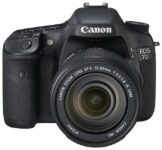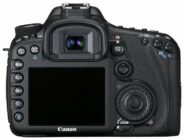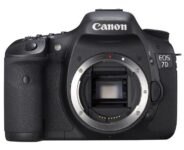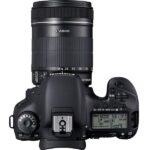Canon EOS 7D
APS-C AF digital SLR camera
Specification
| Production details: | |
| Announced: | September 2009 |
| System: | ● Canon EOS APS-C (2003) |
| Format: | |
| Maximum format: | APS-C |
| Imaging sensor: | 22.3 × 14.9mm CMOS sensor |
| Resolution: | 5184 × 3456 - 18 MP |
| Crop factor: | 1.61x |
| Sensor-shift image stabilization: | - |
| Mount and Flange focal distance: | Canon EF-S [44mm] |
| Shutter: | |
| Type: | Focal-plane |
| Model: | Electronically controlled |
| Speeds: | 30 - 1/8000 + B |
| Exposure: | |
| Exposure metering: | Through-the-lens (TTL), open-aperture |
| Exposure modes: | Programmed Auto |
| Aperture-priority Auto | |
| Shutter-priority Auto | |
| Manual | |
| Physical characteristics: | |
| Weight: | 820g |
| Dimensions: | 148.2x110.7x73.5mm |
Manufacturer description
London, UK, 1 September 2009: Canon today unveils the EOS 7D digital SLR camera – a completely new design to meet the specific demands of photographers. Incorporating a new 18MP APS-C CMOS Sensor, developed by Canon, the EOS 7D also features: Dual “DIGIC 4” processors to offer fast, high-quality performance in all light conditions, an ISO range expandable to 12,800 and continuous shooting at 8 frames per second – without the need for additional accessories. Impressive technologies are matched by excellent build-quality designed with the photographer in mind – to create a whole new photographic experience.
During extensive development Canon went back to the drawing board, listening to photographers worldwide in order to design the EOS 7D to meet their specific needs. Commenting on the creation of the EOS 7D, Mr. Shinbori, Deputy Group Executive of Photo Products Group & Senior General Manager of Camera Development Center, Canon Inc,said “We consulted over 5,000 photographers worldwide and asked them what they most wanted to see from a camera. Matching this insight with cutting-edge technology, we were able to develop a camera that truly gives photographers the versatile tool they require to experiment with their images.”
Accurate Images – High performance AF and metering systems
The EOS 7D features a 19-point cross-type AF sensor, enabling photographers to achieve accurate shots and optimise composition options. This improved AF system offers a range of manual and automatic settings including Zone and Spot AF to track and capture subjects quickly and accurately. AF settings are highly customisable, allowing for rapid reaction to changes in the scene. Different AF points can be set for vertical or horizontal orientation, so photographers can automatically switch between landscape and portrait shots without touching a button.
The EOS 7D also incorporates a new metering system. The Focus Colour Luminance metering system (iFCL) intelligently measures focus, colour and luminance, across 63 zones. Complementing the 19 AF points, the dual layer sensor is able to gather information from each distinct zone to obtain a more accurate and consistent exposure.
Capture images exactly as you see them
The Canon EOS 7D features an Intelligent Viewfinder that offers photographers 100 per cent frame coverage. With 1.0x magnification* - a first for EOS - photographers see a large bright image that helps to fully immerse them within the shot. A transmissive LCD incorporated in the viewfinder allows photographers to choose between various overlay features - such as AF points, the spot metering circle and composition grid – providing a range of tools that help when framing a shot. The EOS 7D is also the first EOS to introduce a Dual-Axis Electronic Level – in the viewfinder and on the LCD - that indicates both pitch and roll angles. This feature is particularly useful when shooting landscapes to ensure a level horizon, or when used in conjunction with a Tilt and Shift lens to level the camera.
The camera features a new 3 inch Clear View II LCD screen with a solid structure screen, designed to combat glare by removing the air-gap between the LCD’s protective cover and the liquid crystal. This new screen has a viewing angle of 160 degrees and is effective even in bright light. As with the EOS 5D Mark II, an ambient light sensor on the side of the screen can set brightness automatically depending on the environment.
Experiment creatively with light
The Canon EOS 7D is equipped with an Integrated Speedlite Transmitter. For the first time in an EOS, photographers can control external Speedlites with no additional accessories - ideal for those looking to experiment with creative lighting set-ups. The EOS 7D also features an extensively upgraded, built-in flash including manual control, and wider flash coverage to cover focal lengths as wide as 15mm.
Customise your individual camera experience
The EOS 7D has been conceived and designed with the photographer’s needs in mind. The look and feel of the camera has been aesthetically and ergonomically crafted to offer photographers the very best interaction. To this end, the photographer can design their own experience – camera operations are customisable, allowing the user to assign frequently used functions and settings to convenient controls. This enables photographers to save time when shooting critical moments, by changing settings quickly. Impressive Features, Impressive Images
The Canon EOS 7D is packed with new features:
- 18 MP APS–C CMOS Sensor: Designed and manufactured by Canon, the sensor produces an outstanding image and offers fantastic performance at high and low conditions, thanks to a new photodiode and microlens construction.
- 8 fps image capture: Enabled by the Dual “DIGIC 4” processors and improved electrical system, photographers can capture images at 8fps, without the need for additional accessories and in all file types.
- ISO Range: The EOS 7D enables photographers to capture subjects in their natural light. The ISO range (100 – 6,400) is expandable to 12,800.
- EOS Movie: With improved operation, making it easy to switch directly to movie mode, it is now even simpler to shoot Full HD video. Users can set exposure and frame rate – with options for 24 fps to create that cinematic feel.
- Dual “DIGIC 4” processors: By utilising Dual “DIGIC 4” processors, users of the EOS 7D never have to compromise between shooting speed, image quality and ISO performance.
- Impressive Design: Canon has listened to photographer feedback when designing the body, as well as the internal technologies. A magnesium alloy body offers environmental protection – the tough, lightweight construction is designed to defend against moisture, and dust – equivalent to the legendary EOS–1N.
The camera is compatible with a wide range of accessories so it can easily be integrated with a photographer’s workflow. The Wireless File Transmitter (WFT-E5) allows extensive camera control via a web browser – allowing photographers to control the camera using a web-enabled mobile device.
The EOS 7D is compatible with all EF and EF-S lenses as well as Canon EX Speedlites. The Canon EOS 7D can also be used with Battery BG-E7, and remote controllers and switches such as the remote Controller RC-1/RC-5.
Technologies Explained:
Canon CMOS sensor
The EOS 7D includes a new 18 megapixel CMOS sensor with a wide ISO range that delivers excellent results in both the low and high-speed ranges as well as improved image quality. The sensor is a standard APS-C size (22.4x14.9mm) and produces an effective field of view of 1.6x the lens focal length.
The EOS 7D sensor features condensed circuitry with improved sensitivity and increased capacity of the photodiodes, which enables shooting at high ISO and prevents overloading when shooting in bright conditions. The ISO range (100 - 6400) is expandable to 12800 enabling photographers to capture subjects in their natural light without the use of a flash.
The EOS 7D sensor includes gapless microlenses that have been moved closer to the photodiodes. These technological advances, which were developed and manufactured by Canon, improve the signal to noise ratio creating very clean high ISO images.
19-point cross-type AF system including Spot AF
The AF system has been completely redesigned using the same architecture as the EOS-1 series and includes a separate processor to handle AF calculations. This, along with AI SERVO II AF, enables the EOS 7D to offer accurate, reliable and continuous shooting at 8fps. Uniquely at this level, all 19 points in the EOS 7D AF sensor are cross-type points with f/5.6 or faster lenses, which allows sophisticated tracking, accuracy and performance throughout the frame.
EOS 7D also includes Spot AF, a new mode that uses a smaller area of the sensor to determine focus. This is useful for small subjects where there is background detail that can distract the AF sensor. It also includes Zone AF which limits automatic selection to one of five zones. This allows photographers to ensure their subject is automatically selected.
iFCL metering system with 63-zone Dual-layer Sensor
The iFCL system uses Focus, Colour and Luminance information to determine consistently exposed shots. All focus points provide distance information to the metering system to determine proximity to the subject and allow the algorithm to weight the exposure accordingly. EOS 7D has a completely new metering sensor with 63 zones compatible with 19 AF points. Typically, metering sensors are more sensitive to red subjects which can lead to overexposure. EOS 7D combats this with the dual layer sensor, which has one layer sensitive to red and green light and one that is sensitive to blue and green light. The metering algorithm then compares the level of the two layers and adjusts the meter reading accordingly.
100% Viewfinder with 1.0x magnification and built in LCD overlay
The EOS 7D features a high quality viewfinder with 100% coverage and 1.0x magnification - a first for EOS - making it simple and ease to use. The viewfinder uses a prism, coating technologies and eyepiece lenses inspired by the EOS-1 series.
EOS 7D viewfinder does not have interchangeable focussing screens. In their place is a Transmissive LCD Screen - another first for EOS. Through technological advances Canon has been able to implement the screen whilst maintaining viewfinder image quality. This new feature, which can be illuminated in lowlight, enables grid, spot metering and AF points to be superimposed upon demand.
EOS Movie
The EOS 7D features an improved movie function allowing users to record Full HD movies with full manual control and selectable frame rates. The operation of the movie function has been improved to make it easier to use via direct access to settings with dedicated buttons. AF can now be started by either half pressing the shutter button or using the AF-ON button as before.
The exposure of the movie can be controlled in Manual mode allowing full control of shutter speeds and apertures. It is possible to select frame rates from: 30 (29.97), 25, and 24 (23.976), with 60 (59.94) and 50 available at 720p. ISO can be set automatically or manually in the range (100-6400) and is expandable to 12800. EOS 7D also allows users to trim and cut their movies.
Dual “DIGIC 4”
EOS 7D is fitted with Dual “DIGIC 4” processors; the power of the processors enables more advanced processing algorithms allowing the camera to achieve a high performance 8fps at 18 megapixels.
DIGIC 4 removes the highly noticeable colour noise as well as reducing luminance noise without loss in detail, allowing for very clean high ISO images. Even at ISO 6400 noise levels are similar to those of ISO 1600 from DIGIC III. Auto Lighting Optimiser is now also available during manual exposure, without any drop in performance.
DIGIC 4 also allows UDMA cards (mode 6) to be used at their full speed, which allows the EOS 7D to take advantage of the fastest cards available.
Clear View II
EOS 7D’s 3 inch LCD monitor has 920,000 dots (VGA resolution) with a viewing angle of 160°. Clear View II has been designed to combat glare by removing the air-gap between the LCD’s protective cover and the liquid crystal. The air-gap is filled with an elastic optical material. This has the affect of suppressing the reflections from the surface of the liquid crystal, caused by the sharp change in refractive index, as light travels through the air-gap. In order to protect the liquid crystal from scratches the Clear View II LCD features a hardened glass cover material. As with the EOS 5D Mark II, an ambient light sensor on the side of the screen can set brightness automatically depending on the environment.
Table of contents
Clickable
Instruction manual
Clickable
Canon EOS APS-C system cameras
Clickable
- Canon EOS 1000D
- Canon EOS 100D
- Canon EOS 1100D
- Canon EOS 1200D
- Canon EOS 1300D
- Canon EOS 2000D
- Canon EOS 200D
- Canon EOS 20D
- Canon EOS 250D
- Canon EOS 300D
- Canon EOS 30D
- Canon EOS 350D
- Canon EOS 4000D
- Canon EOS 400D
- Canon EOS 40D
- Canon EOS 450D
- Canon EOS 500D
- Canon EOS 50D
- Canon EOS 550D
- Canon EOS 600D
- Canon EOS 60D
- Canon EOS 650D
- Canon EOS 700D
- Canon EOS 70D
- Canon EOS 750D
- Canon EOS 760D
- Canon EOS 77D
- Canon EOS 7D
- Canon EOS 7D Mark II
- Canon EOS 800D
- Canon EOS 80D
- Canon EOS 850D
- Canon EOS 90D




